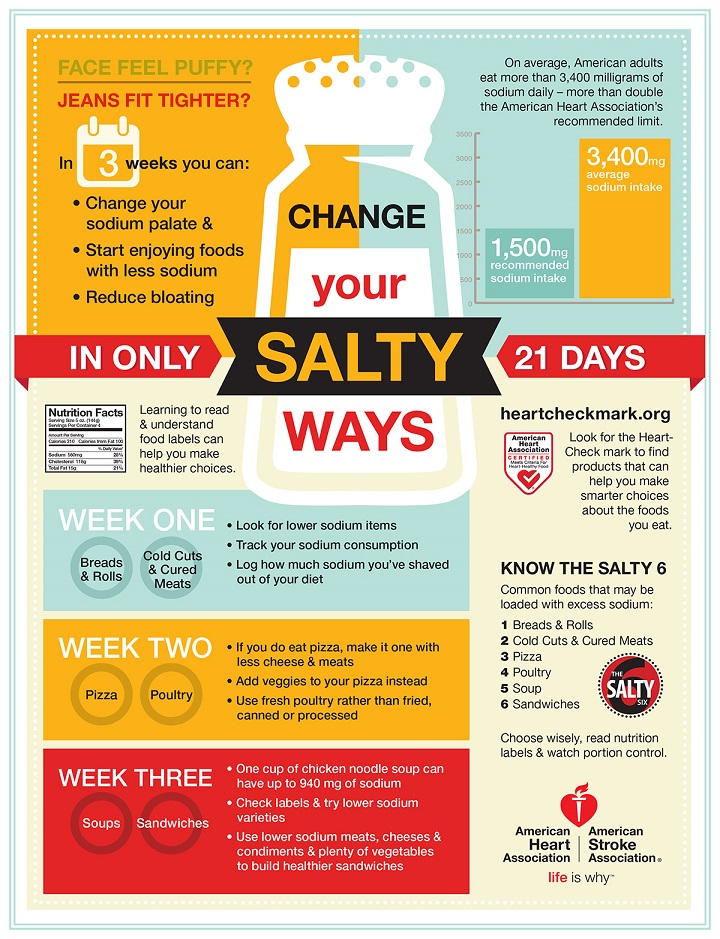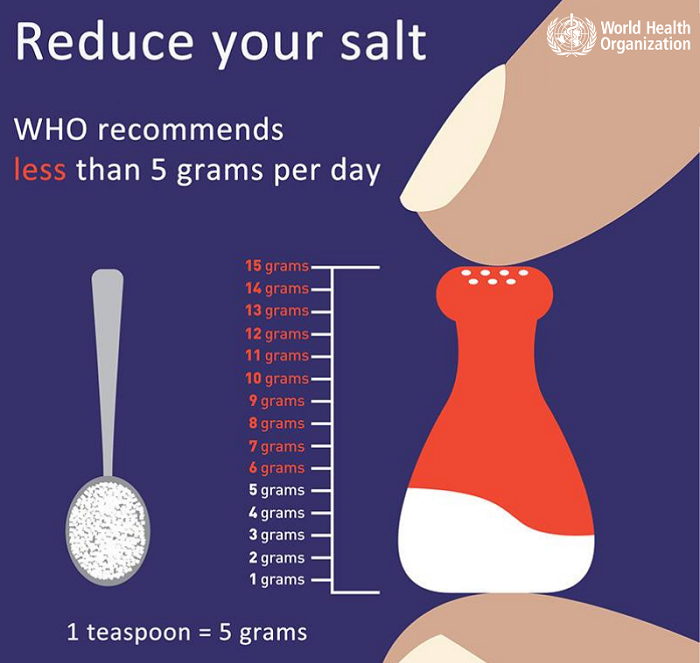The World Health Organization recommends that you take steps to reduce your salt intake by getting no more than 5 grams of salt per day. They estimate that, globally, 2.5 million deaths could be prevented each year if salt consumption stayed within its recommended guidelines. But on average, people are consuming about twice as much salt as they should. That can lead to health problems such as high blood pressure, heart disease, stroke and kidney problems.
The Harvard School of Public Health explains more about health problems related to sodium:
“In most people, the kidneys have trouble keeping up with excess sodium in the blood. As sodium accumulates, the body holds onto water to dilute the sodium. This increases both the amount of fluid surrounding cells and the volume of blood in the bloodstream. Increased blood volume means more work for the heart and more pressure on blood vessels. Over time, the extra work and pressure can stiffen blood vessels, leading to high blood pressure, heart attack, and stroke. It can also lead to heart failure. There is some evidence that too much salt can damage the heart, aorta, and kidneys without increasing blood pressure, and that it may be bad for bones, too. “
OK, that leads to some questions.
- What does 5 grams of salt look like?
- Are salt and sodium the same thing?
- What can we do to reduce our health risks of salt & sodium?
Here in the U.S., most people aren’t all that familiar with grams. As a rule of thumb, 5 grams of salt is the equivalent of one teaspoon. But it’s not quite that simple. it is estimated that 70-80% of our salt intake is from processed foods, which is measured in sodium on our US food labels.
Many people think sodium is just another word for salt, but that is a misconception. Sodium is a mineral and one of the chemical elements found in salt.The Dietary Guidelines for Americans recommends limiting sodium intake to less than 2,300 mg per day – that’s equal to about 1 teaspoon of salt (or 5 grams of salt) So the dietary guidelines are roughly equivalent:
5 grams of salt = about one teaspoon
One teaspoon of salt = 2300 milligrams of sodium
Here’s a compilation of tips on how to reduce your salt and sodium intake from health experts:
- Cut back on the amount of packaged foods you eat – particularly highly processed foods. According to the CDC, the top 10 sources of sodium in our diets include: breads/rolls; pizza; sandwiches; cold cuts/cured meats; soups; burritos, tacos; savory snacks (chips, popcorn, pretzels, crackers); chicken; cheese; eggs, omelets.
- Cook your own meals as often as you can using fresh foods.
- Taste food before you salt. Don’t keep a salt shaker on the table.
- Pay attention to food labels and content. Get familiar with the terms. Compare labels when shopping and choose lower sodium alternatives. Ask about low salt alternatives when dining out.
- Limit the consumption of salty snacks. Eat smaller portions of salty foods.
- Wean yourself off of salt to gradually retrain your taste buds. It can be tough to make the leap all at once and you might set yourself up for failure if you go “cold turkey.” Focus on gradual changes.
- Discover other seasonings and flavorings on your food. Experiment with different herbs and spices.
- Eat foods high in potassium to help counter the effects of salt on blood pressure.
More useful resources
- American Heart Association: Get the Scoop on Sodium and Salt
- Mayo Clinic: Sodium: How to tame your salt habit


